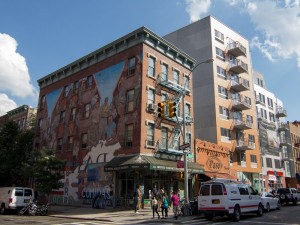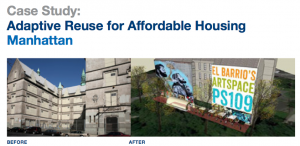On Monday, NYC mayor Bill de Blasio released his ambitious 10-year, $41 billion affordable housing plan, which proposes creating 80,000 new units of affordable housing and preserving 120,000 more city-wide. It emphasizes greater urban density, building up, and implementing some requirements (as opposed to current incentives) for developers to include affordable housing in new construction.
What does this mean for East Harlem, a neighborhood whose affordable housing stock is dwindling as gentrification, particularly in the form of newly-constructed luxury housing, raises the overall market value of apartments.
According to a 2012 report issued by Manhattan Community Board 11, which represents the neighborhood, most East Harlem residents live in some form of rent-regulated housing. East Harlem has one of the highest concentrations of public housing in the city and much of the remaining housing stock has been rent-regulated. However, as the report suggests, the expiration of government subsidies will likely price current residents out of their homes. A third of rent regulations will progressively expire by 2040.
City-wide, rents have gone up nearly 40 percent in the last 20 years, while renters’ wages have risen less than 15 percent. Nearly a third of the city’s households who rent pay more than 50 percent of their income in rent and utilities. According to the 2012 U.S. Census, the median income of East Harlem households is $31,444.
Currently, despite incentives such as tax breaks for new construction and financial assistance to property owners to keep their buildings from turning market-rate, more rent-regulated apartments are lost to deregulation than new ones are built (source).
The strategies proposed in the 2012 Community Board 11 report may dovetail with the Mayor’s proposed plan. The Community Board 11 report recommends coordinating efforts to maintain the supply of rent-regulated housing, and working with building owners to promote continued participation in programs that will preserve affordable housing. If successful, de Blasio’s plan will preserve the current supply of affordable housing and both regulate and incentivize the creation of new stock. However, how the plan will be funded and implemented remain to be seen and it’s a question of how much affordable housing will be left to preserve in East Harlem and how many opportunities there will be to intervene in new development by that point.
The mayor’s report highlights El Barrio’s Artspace P.S. 109, which is an affordable housing project for artists, as an example of adapting existing structures into housing. This project was developed by Minneapolis-based developer Artspace with grant funding from the Warhol Foundation for the Arts. While this unique project may not be able to be replicated at a scale that meets the community’s overall needs, it is a start.
Reclaiming property for housing and building on vacant lots is what activist organization Picture the Homeless has been vying for. Working with the Hunter College Center for Community Planning and Development, the group identified enough abandoned and unoccupied space in the city to house all of the homeless, outlined in this 2012 report. In their study of city housing data, they found a total of 143 vacant buildings and lots in East Harlem that could house 9,252 people. Perhaps implicitly acknowledging the organization’s exhaustive work, the mayor’s report calls for conducting a comprehensive survey of all the vacant sites in the city, potentially corroborating their data and analysis.
Overall, the plan has the potential to address at least some of the community’s urgent housing needs and ideally help shape a healthier community development over the usual displacement-through-gentrification.




